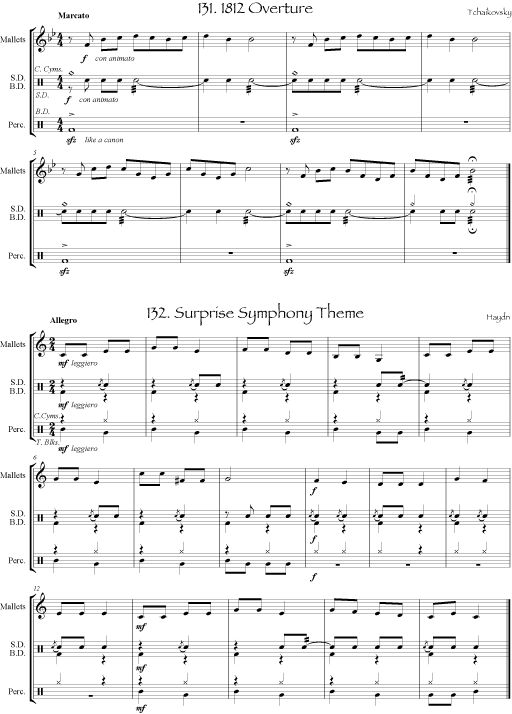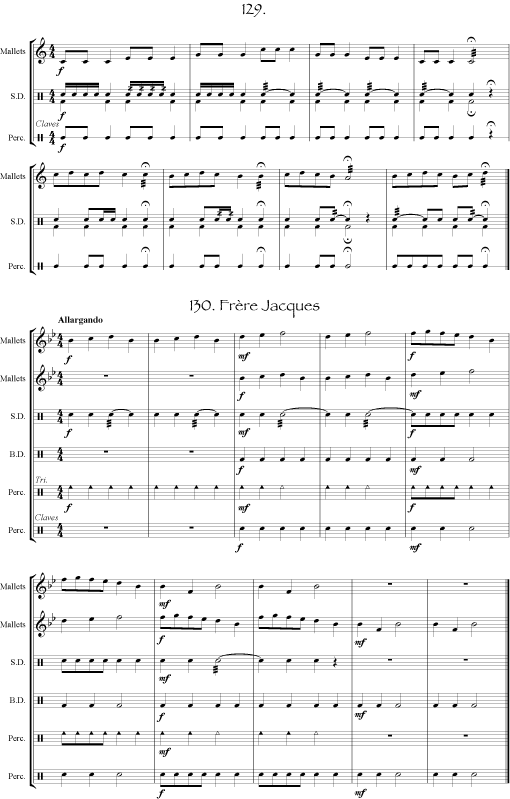 A 1-year Australian Band Method written by Sam Seabrook.
A 1-year Australian Band Method written by Sam Seabrook.
Features of Each Part
Flute
- first notes introduced are C, Bb and A
- tunes and exercises with repeated quavers reinforce tonging action
- range focused around one octave of F major until good embouchure has a chance to establish
- keys of C, F, Bb, and Eb introduced
- rhythmic accompaniment parts written when the melody is elsewhere
- full dynamic range encouraged
- swing style introduced
- scales thoroughly introduced through exercises that can be played with different instrumental combinations
- 6/8 introduced through well recognised tunes and rounds
- specific exercises to assist in moving into the the second register
- exercises in the A section work on the difficult areas that arise in the B section on the lower part of the page
- A section can be used as a tutor in individual lessons. Graded just slightly harder than the B section so as to challenge those who may move ahead a little faster than others.
- many melodies match transposition with the My Favourite Flute Tutor piano accompaniment....perfect for concerts
- special repetitive fingering exercises to assist in the awkward areas of the range
- long note exercises
- tonging patterns for scales introduced
- duets from My Favourite Duets that match with many other instruments to encourage friends to play together
- first notes introduced are C, Bb and A
- oboe parts kept in unison or octaves with the flutes for the beginning of the book
- specific exercise for awkward fingering passages
- half hole exercises for the introduction of D in the second register
- notes remain in the lower register to begin with to allow a strong foundation for the tone to develop
- exercises introducing gradually widening intervals
- alternative F fingerings identified
- exercises that work on the transition into the 2nd register
- rhythmic and harmonic independence from the flutes introduced toward the end of the book
- swing style introduced
- low Bb introduced briefly with alternative note given for those without a Bb
- oboe parts kept away from the flute in the high register to avoid difficult tuning
- exercises that work on developing attack in the lower register
- standard tone exercises to develop listening skills
- first notes E, D and C
- most notes remain in the lower register
- all notes in the upper register have alternative low register notes written on the part
- C over the break introduced from G
- no difficult parts written approaching B from below
- exercises for the introduction of C
- lower register down to low E explored
- specefic exercises for fingering issues around E, F sharp, G and A in the throat notes
- forked Bb introduced
- all notes remain below D over the break
- first notes D, C and Bb
- notes remain in the lower range below F for the first half of the tunes
- careful consideration of the transition to middle G
- bassoon given a share of the melody parts in the full band arrangements
- first notes B, A and G
- get the opportunity to play in C major, G major, D major and A major
- special tonguing exercises
- exercises that work on the use of the register key
- forked F sharp exercises
- first notes C, B, A and G
- get the opportunity to play in F major, C major, G major and D major
- special tonguing exercises
- exercises that work on the use of the register key
- first notes E, D, C
- time spent in the lower half of the first octave so as to develop good support and a strong embouchure
- tone development exercises
- first notes F, E, D, C
- difficult leaps and large intervals avoided
- first notes D, C, Bb
- careful consideration in C major, B avoided
- no awkward position changes from 6th position
- gets the chance to play melodies
- first notes D, C, Bb
- gets the chance to play melodies
- both Eb & BBb fingerings included (& 4th valve alternate fingerings)
- the part is written down to just low A, suitable for both Eb and BBb tubas.
- plays in unison with trombone
- gets the chance to play melodies
- For detailed information on percussion.
- written as a band reduction so as to support each of the instrumental parts in the band
- chord symbols given
- tunes in the students books match with contemporary arrangements in the My Favourite Tutor Book Piano Accompaniment.
- carries all of the bass parts in the band arrangements
Percussion
- All percussion parts are included in the one spiral bound 144 page student book. This gives access to all parts for all percussionists.
- My Favourite Band percussion book is also a fantastic resource for students taking lessons in groups.
- All pieces are scored with a mallet part that carries the melody. Besides being great for band, this is an excellent resource for percussion ensembles.
- A full percussion score is also available for use in sectional rehearsals and percussion ensembles.
The percussion score contains:
Full Band arrangements
- full percussion arrangements for all 72 band tunes (4 or 5 parts)
- see example below
Technical exercises
- 63 exercises that deal with technical issues that relate to the band tunes (4 or 5 parts)
- These exercises can also be used in lessons for technique development.
- The exercises are also scored to be played with the other instruments of the band that also have these exercises.
- (see example below)
Ensemble pieces
- 9 ensemble tunes written for 6 parts that correlate with the duets for the other band instruments
- (see example below)
Percussion instruments included in the book
- Snare drum
- Bass drum
- Mallets
- Timpani
- Suspended cymbal
- Crash cymbals
- Triangle
- Tambourine
- Wood block
- Temple blocks
- Sleigh bells
- Maracas
- Claves
- Hi-hat
- Body percussion
Techniques included in the percussion book
- R and L sticking
- Single paradiddle
- Multiple bounce stroke
- Rim shot
- Flam
- Flam tap
- Flam accent
- Flam paradiddle
- Nine stroke roll
- Five stroke roll
- Seventeen stroke roll
- Rolls (percussion, timpani and mallets)
- Double stops
- Open and closed triangle
Also...
- Five line and one line staves used for percussion.
- Unique pictures showing instrument playing positions.
- Comprehensive scales index for mallet instruments.
- Full glossary of musical terms.
- Introductory rhythm page.
Full band parts from A Section - My Favourite Band percussion score

Exercise & Duet from B Section - My Favourite Band percussion score

Fingering Charts
Fingerings charts & position guides
Two options are given for fingerings in My Favourite Band. Each time a new note is introduced, the fingering as well as the notation is given. Also included is a one page reference chart that includes all the fingerings.
Each fingering has been specially designed from musical characters giving a stylish look while remaining easy to read.
A & B Sections
A & B sections on each page
If the student is playing a harmony part in the A section of the page then they will have the melody in the B section.
These melodies often match the key of the A section and can be added to the band parts at the discretion of the teacher. This allows better balance of your individual bands as there is always a unique mix of abilities and instruments for each year. It also allows those students who are up for a bit of a challenge to excel as the B section is generally graded just slightly harder than the A section.
This melody will often also match transposition with My Favourite Tutor Book Piano Accompaniment. This is indicated with the piano symbol. This accompaniment is written in a contemporary style by Graeme Vendy and provides a backing that is both musically interesting and supportive. Having accompaniment available allows the students to also use this book in lessons, for assessments and for concerts.
If an instrument has the melody in the A section (band parts) there is an exercise written in the B section that relates to any issues that are introduced within this melody. This means tricky passages and also particular rhythms. Each of these exercises are progressive and also match in transposition with other members of the band. This makes them perfect for working with certain sections in full band or sectional rehearsals, and also makes this book useful as a personal tutor that can be used in lessons.



